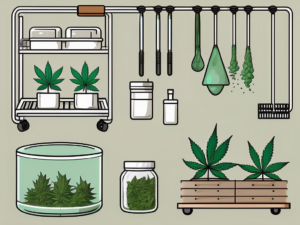How do you get the best overall end product in cannabis?
Fancy labels, clever products, and good salespeople all create a better return for a cannabis business, but are they the most important part of the puzzle?
While they do increase your chances of success, there is one major key to getting the most out of your cannabis business – the quality and yields of the plant you produce.
So, how do you get a quality end product? Success depends on the time and attention spent on planning and scheduling your process throughout cultivation – from when the first seeds are put down into the soil, all the way to cutting down the flower.
Three Key Themes for a Better Grow
Lets get more specific. There are three important topics/themes that will help you run a better grow. Note that these are broad topics. The nuts and bolts of growing are as unique and varied as the grower, and we think, best left up to you, the grower to decide on. The topics we will cover:
- Planning – knowing what you’re going to do before doing it. And thinking about things that can go wrong with your plan (they will!).
- Communication – making sure everyone else knows what you’re planning. This may be the most important part of an effective grow process.
- Execution – making sure things get done in the grow, and done right (see communication above!).
Plan each step before you start
Remember in college, when you had a single plant in your bedroom that you watered randomly? Do you remember how much flower it yielded? Probably not much I’d wager (my first plant was in a planter outside my dorm!). To get a dense flower with a high THC percentage, especially at scale, you need to schedule out each individual step involved to get from clones to flower.
So, how to best create a plan of schedule? In the past, a simple notebook with a list of steps was the norm. Now larger commercial operations use white boards, email, and excel documents to plan out large harvests. Recently there’s been an explosion of dedicated cultivation management software specifically for optimizing your grow.
Takeaway: Whatever your method, making sure you have a in-depth plan for every step of your process beforehand is essential to having a successful harvest.
One last note on planning. Every harvest has issues. What happens when an employee doesn’t show up for work? If you have a new hire to train? If you’re running a perpetual harvest, and a room gets held up, how will you adjust the rest of your schedule as to not hold up all your harvests? These are harder questions to answer, but it’s important to think about the best way to handle them before getting started.
Communication everything systematically
Effective communication is the single most important aspect of any successful cannabis grow. Think about it – you can have the best grow process in the world, but if nobody knows how to execute it, then you’ll never produce the quality plant you want.
There are many ways to communicate information and schedules in a commercial cannabis grow. I worked with a company that left notebooks in each room, with grow schedules for each that slowly got crossed off for each. Whatever your approach, consistency is key. You need to communicate the same way, every day. This leads to more familiarity with each task, and each grower will gain more expertise over time.
Tried and true communication styles like whiteboards, daily meetings, and notebooks have worked for over a decade. It will be interesting however, as the markets grow and competition becomes more fierce, whether finding a better way to relay information via purpose-built software will become the new normal for commercial cannabis cultivations.
Takeaway: Make sure that the entire group knows what’s happening daily, at a minimum. Grow managers, schedule makers, and owners should have a more zoomed-out view, preparing for what’s coming weeks or months ahead of time.
Execute with SOP's
Good planning and communication leads to great execution. That’s why it’s last on this list! You have to have a quality grow schedule that you know will produce a high yield of quality flower, and established clear lines of communication first. Only after that can you get to work.
In doing the work, Standard Operating Procedures, or SOP’s for short, are essential to make sure everyone is on the same page. When upskirting a plant, how aggressive are you getting? If a pot feels heavy, but the schedule indicates it needs feed, how much will you water it? Will the employee know to check whether the plant is heavy in the first place? You need to know the answers to these questions, and also communicate them well. Especially as you scale, how you plan out SOPs and communicate them will make a big difference in the success of the commercial cannabis cultivation.
Another key part of execution is not only establishing how work should be done but also letting growers know after the fact whether they’re doing a good job. Creating feedback, and standardizing it with check-ins every week or month, reinforces the correct execution in the cannabis cultivation.
Additional Tips for Executing a Commercial Cannabis Cultivation Plan
Proper facility design and workflow are crucial for efficient commercial cannabis cultivation operations. This includes:
- Optimizing room layouts and zoning for different cultivation stages (propagation, vegetation, flowering, drying, etc.)
- Establishing smooth traffic flows for employees, materials, and product movement
- Incorporating quarantine areas and air locks to maintain clean environments
- Installing adequate storage spaces for supplies, equipment, and inventory
- Utilizing vertical racking systems or multi-tier grow setups to maximize space utilization
Adopt Automated Systems and Data-Driven Processes
Automating processes and leveraging data can streamline operations, improve consistency, and reduce labor costs in commercial cannabis cultivation facilities.
- Implement environmental control computers to automate lighting schedules, climate controls, and fertigation systems
- Use cultivation management software to track plant data, inventory, schedules, and SOPs
- Integrate sensor networks and data loggers to monitor growth conditions remotely
- Utilize mobile apps and digital task management tools for efficient team communication and coordination
- Analyze cultivation data to identify areas for process optimization and improved resource allocation
Establish Rigorous Quality Control and Compliance Measures
Quality control and regulatory compliance are critical for commercial cannabis operations to ensure product safety, consistency, and legal compliance.
- Develop and follow strict Standard Operating Procedures (SOPs) for all cultivation processes
- Implement Good Agricultural Practices (GAPs) and Good Handling Practices (GHPs) throughout the facility
- Conduct regular testing for potency, contamination, and safety parameters
- Maintain detailed records and batch tracking from seed/clone to sale
- Stay up-to-date with local, state, and federal regulations and licensing requirements
- Perform regular audits and inspections to identify and address any non-compliances
Foster a Culture of Continuous Improvement
Continuously improving processes is essential for maintaining operational efficiency and staying competitive in the commercial cannabis market. Fostering this culture takes a specific set of skills, and management:
- Encourage employee feedback and suggestions for process improvements
- Conduct regular team meetings and debriefings to review successes and challenges
- Analyze yield data, resource usage, and cycle times to identify bottlenecks or inefficiencies
- Invest in ongoing training and professional development for cultivation staff
- Stay informed about industry advancements and best practices through networking and conferences
- Be willing to test and implement new technologies, techniques, or products that can enhance operations
By focusing on efficient facility design, automation, quality control, compliance, and continuous improvement, commercial cannabis cultivators can effectively execute their cultivation plans and achieve consistent, high-quality yields.
Know what you'll do before you do it, communicate well, and watch your plant yields skyrocket
In summary, if you want to compete, thoroughly planning how your harvest schedule will work before your first clone is a crucial first step. Once you’re growing, having a system to communicate what needs to be done each day on your schedule ensures that the work actually gets done. Lastly, how you execute the work is the most important.
If you can plan, communicate, and execute, over time you’ll consistently hit the yields you’re looking for, and set your cannabis business up for success in the long term.



